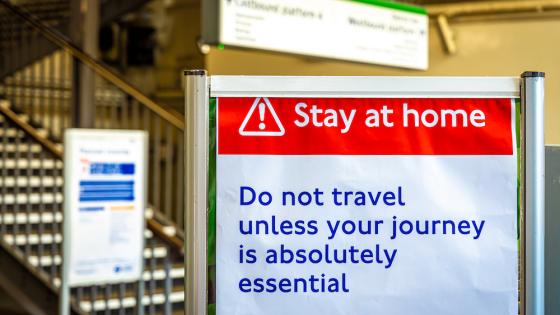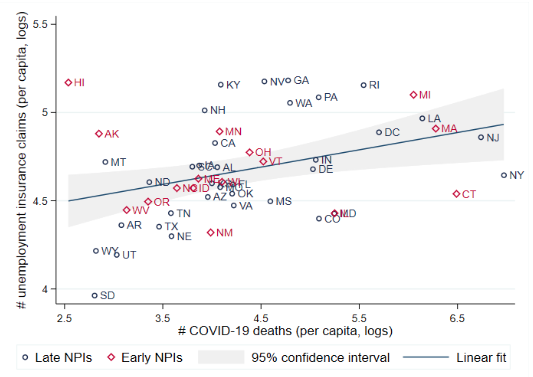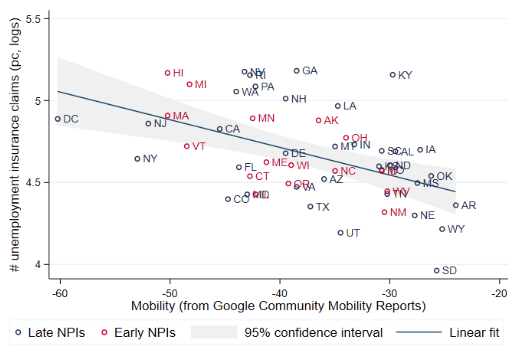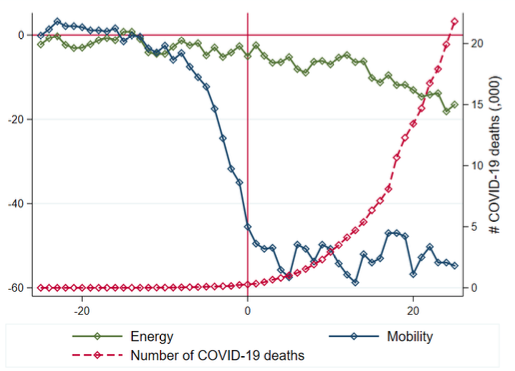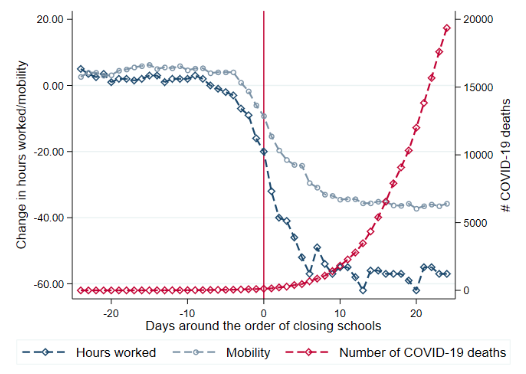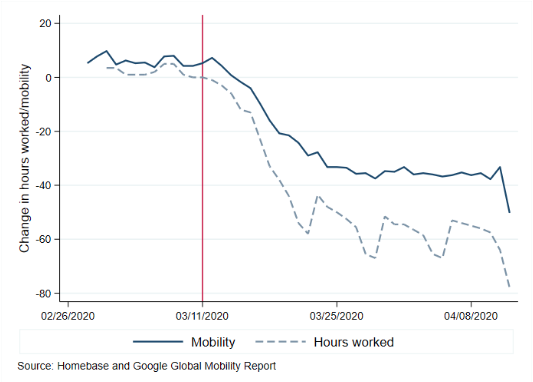The COVID-19 pandemic is causing economic disruption at unprecedented speed and scale (Baldwin and Weder di Mauro 2020, Baker et al. 2020, Gopinath 2020). Thirty million Americans filed for unemployment in the past six weeks. It took about a year to reach that number in the wake of the Lehman Brothers’ bankruptcy. Meanwhile, euro area GDP contracted by 3.8% in the first quarter of 2020 (Eurostat 2020). Against this background, the relatively slow frequency of most official statistics and macroeconomic indicators represents a challenge for policymakers in their efforts to mitigate the economic impact of the crisis.
In recent work (Chen et al. 2020), we rely on several high-frequency indicators, such as electricity usage, smartphone movements, employment for small businesses and hourly workers, and unemployment insurance claims to track the economic impact of COVID-19 in Europe and the US. Our work provides evidence to help policymakers tailor their responses to “flatten the recession curve” (Gourinchas 2020).
COVID-19 and economic activity in Europe…
Electricity is an input in most of economic activity and is difficult to substitute in the short run. Electricity usage is a very useful high-frequency indicator of economic fluctuations, and data on electricity usage are available with almost no lag for many European countries (Cicala 2020). Despite lower energy prices, weekly (workdays) electricity usage has been declining in most European countries: for the median country in our sample, electricity usage was about 5% lower than in 2019 during early March and the drop accelerated to 15% during mid-April. According to our energy elasticity estimates, during a crisis, a 1% drop in electricity usage is associated with 1.3% to 1.9% lower output.
Countries with more severe outbreaks, as measured by deaths per capita, and a sharper decline in people’s mobility have reduced their electricity usage more (Figure 1). These results are robust to controlling for the share of manufacturing in national production and weather conditions. The estimated coefficient suggests that during the acute stage of the pandemic, a doubling of the COVID-19 outbreak is associated with 2.4% lower electricity usage, or 3.1 to 4.6% lower production. This is a non-trivial amount, given that the number of cases can double every two or three days during the early phase of the pandemic.
Figure 1 COVID-19 and electricity usage in Europe: Cross-section
A. Electricity usage and COVID-19 deaths
B. Electricity usage and mobility
Source: ENTSO-E, ECDC, Google COVID-19 Community Mobility Reports.
Note: Panel A plots the percent change in weekly electricity usage relative to the same week in 2019 and the number of COVID-19 deaths per capita in 32 continental European countries. Panel B plots the percent change in weekly electricity usage relative to the same day of the same week in 2019 and the percent change in visits public places (retail and recreation, grocery and pharmacy, transit stations, and workplaces) within a geographic area relative to the pre-COVID-19 period. Bubble size corresponds to the number of COVID-19 deaths per capita. In both charts, the solid line plots a linear fit and the grey area shows the 95% confidence interval bands. The sample is the week ending on April 11, 2020, but we find similar results using any other week during late March/mid-April.
… and in the US
In the US, average daily electricity usage in early April was 5% lower than the same period in 2019. More strikingly, 30 million new unemployment insurance claims have been filed since the outbreak of the pandemic, implying a dramatic reduction in employment and labour force participation (Bick and Blandin 2020, Coibon et al. 2020 among others). Job losses, as well as hours worked and employment in local small businesses, are concentrated in states that have been hit harder by COVID-19 (Figure 2, Panel A). This result is in line with recent evidence shown for US cities during the 1918 flu pandemic (Correia et al. 2020), but is different from early evidence on the impact of COVID-19 in Spain (Carvalho et al. 2020).
Exploiting both the time and cross-sectional dimensions of the data, we see that as the number of COVID-19 positive cases grows, so does the number of unemployment insurance claims. However, this elasticity has weakened over the first few weeks—in the first week in which the number of claims spiked the elasticity was close to 0.3, while now is close to 0.1—suggesting that the labour market has reacted very fast to the outbreak and the related social distancing measures put in place to contain the epidemic. Moreover, the economic reaction has been so far heterogenous across US states: for a given severity of the outbreak, job losses and the reduction in hours worked have increased more in poorer states, in states with a lower employment share in hotels and leisure, as well as a lower share of jobs that can be done from home, and in states that do not have laws for paid sick days.
Figure 2 COVID-19, NPIs, mobility, and unemployment insurance claims in the US
A. Unemployment insurance claims and COVID-19 deaths
B. Unemployment insurance claims and mobility
Source: US Department of Labour, US Census Bureau, https://covidtracking.com, https://github.com/Keystone-Strategy/covid19-intervention-data, and Google COVID-19 Community Mobility Reports.
Note: Panel A plots the total number of unemployment insurance claims per capita (in logs) and the total number of COVID-19 death per capita, at the state level, from March 8 to April 25, 2020. The solid line plots a linear fit. The slope is 0.10 (s.e.=0.04). Panel B plots the total number of unemployment insurance claims per capita (in logs) and the percent change in visits to various places (grouped under four categories: retail & recreation, grocery & pharmacy, transit stations, and workplaces) within a geographic area relative to the pre-COVID-19 period, at the state level, from March 8 to April 25, 2020. The solid line plots a linear fit. The slope is -0.017 (s.e.=0.004). States are divided between early (red labels) and late (blue labels) NPI adopters. The NPIs considered are: social distancing, closure of nonessential services, closure of public venues, school closures, and shelter-in-place orders. A state is considered an early NPIs adopter if all these five policies have been implemented within a week from the day in which the first death in the state has been recorded.
Economic contraction and mitigation efforts
The contraction in economic activity is strongly associated with observed decline in mobility, which reflects both voluntary and coerced social distancing. In contrast, the relationship between de jure non-pharmaceutical interventions (NPIs) and economic contraction is weaker. The cross-sectional correlation between the electricity usage across European countries and the stringency of mitigation policies is statistically significant only in the early weeks of the pandemic but not in April. The timing of the NPIs is not significantly associated with the number of unemployment insurance claims in the US, whether we control for the size of the local outbreak and other state-level characteristics or not. This early evidence suggests that de jure NPIs are only part of the story. Compliance and voluntary social distancing matter too.
To better understand the role of voluntary and coerced social distancing we look at the evolution of mobility and economic activity over time. In Europe, stay-at-home orders were adopted when the decrease in mobility and electricity usage was already sizeable (Figure 3, Panel A). By contrast, earlier interventions, such as school closures seem unanticipated (Figure 3, Panel B) and acted as a ‘trigger’ for the drop in mobility and electricity usage.
For the US, we find that the sharp decline in mobility and hours worked – relative to January – begins well before the introduction of de jure NPIs at the state level (Figure 4, Panel A). This is true, although to a lesser extent, even in the case of school closures (which were introduced earlier; Figure 4, Panel B).
Figure 3 COVID-19, NPI timing, electricity usage and mobility in Europe
A. Stay-at-home orders
B. School closures
Source: ECDC, Google COVID-19 Community Mobility Reports, ENTSO-E, Hale et al (2020)
Note: The chart plots the median change in electricity usage—with respect to previous year—the median change in mobility relative to the pre-COVID-19 period, across countries, and the cumulative number of Covid-19 deaths for all countries. The x-axis reports the number of days before/after the introduction of NPIs (stay-at-home orders for Panel A and school closure for Panel B). The sample only includes European countries that have adopted the policy by April 10. NPIs introduction and classification is based on Hale et al. (2020).
Figure 4 COVID-19, NPI timing, and hours worked and mobility in the US
A. Shelter-in-place orders
B. School closures
Source: https://covidtracking.com, https://github.com/Keystone-Strategy/covid19-intervention-data, Google COVID-19 Community Mobility Reports, Homebase.
Note: The chart plots the changes in hours worked for a large sample of small businesses and in mobility (both relative to the pre-COVID-19 period) for the median U.S. state, and the cumulative number of COVID-19 deaths for all U.S. states in the sample. The x-axis is the number of days before/after the introduction of NPIs (shelter-in-place for Panel A and school closure for Panel B). The sample only includes states that have adopted the policy by April 30. Figures based on other NPIs, such as closure of non-essential business or public venues, are qualitatively and quantitatively similar to Panel A.
A likely explanation of this difference is that in the US individuals and businesses ‘learnt’ from the European experience and practiced voluntarily distancing and closures before de jure NPIs were adopted. In fact, relative to COVID-19 caseloads during the evolution of the outbreak, NPIs were implemented earlier and mobility dropped earlier in the US than in Europe. The US reached 1,000 COVID-19 cases 11 days after Europe. The first stay-at-home order in the US was implemented 10 days after the first stay-at-home order in Europe (in Italy). But mobility in the US fell by 20% compared to January 2020 just 4 days after Europe (Figure 5, Panel B). Most likely, an important role has also been played by news coverage on COVID-19. The sharp drop in mobility starts on March 12—the day after the WHO declared COVID-19 a pandemic, the NBA suspended its games, and Hollywood star Tom Hanks revealed that he had tested positive.
Figure 5 COVID-19, NPI timing, mobility in Europe and the US
A. Mobility and hours worked in the US
B. COVID-19 and Mobility in the US and Europe
Source: https://covidtracking.com, ECDC, Google COVID-19 Community Mobility Reports, Homebase,
Note: Panel A plots the changes in hours worked for a large sample of small businesses and in mobility relative to the pre-COVID-19 period in the United States. The vertical line is March 11, 2020. Panel B plots the cumulative number of COVID-19 cases and changes in mobility relative to the pre-COVID-19 period in the United States and Europe. The vertical lines are March 9 and March 19, 2020 (state-at-home order issued in Italy and California respectively).
Key takeaways
Our findings suggest that avoiding or delaying NPIs may not fully shield an economy from the COVID-19 shock. Moreover, lifting mandatory lockdown measures – especially when the health crisis is not under control – may not have the expected effect on economic activity, as people would continue to voluntarily limit their mobility. We also show that, although COVID-19 is a truly global shock, regions and countries where the outbreak is more sizeable experience significantly more severe economic losses. This underlines the importance of preventions, early responses, and other health measures to contain the outbreak at the local and national level.
Authors’ note: The views expressed in these notes are those of the author(s) and do not necessarily represent the views of the IMF, its Executive Board, or IMF management.
References
Baker, S, N Bloom, S Davis and S Terry (2020), “COVID-induced economic uncertainty and its consequences”, VoxEU.org, 13 April.
Baldwin, R and B Weder di Mauro (2020), Mitigating the COVID Economic Crisis: Act Fast and Do Whatever It Takes, London: CEPR Press.
Béland, L-P, A Brodeur and T Wright (2020), “The Short-Term Economic Consequences of COVID-19: Exposure to Disease, Remote Work and Government Response”, Wright IZA DP No. 13159.
Bick, A and A Blandin (2020), “Real-time labour market estimates during the 2020 coronavirus outbreak”, VoxEU.org, 6 May.
Carvalho, V, J Ramón García, S Hansen, A Ortiz, T Rodrigo, J V Rodríguez Mora and P Ruiz (2020), “Tracking the COVID-19 crisis through the lens of 1.4 billion transactions”, VoxEU.org, 27 April.
Chen, S, D Igan, N Pierri and A F Presbitero (2020), “Tracking the Economic Impact of COVID-19 and Mitigation Policies in Europe and the United States”, IMF Special Series on COVID-19.
Cicala, S (2020), “Early Economic Impacts of COVID-19 in Europe: A View from the Grid”, unpublished manuscript.
Coibion, O, Y Gorodnichenko and M Weber (2020), “Labor Markets During the COVID-19 Crisis: A Preliminary View”, VoxEU.org, 14 April.
Correia, S, S Luck and E Verner (2020), “Pandemics Depress the Economy, Public Health Interventions Do Not: Evidence from the 1918 Flu”, unpublished manuscript.
Dingel, J I and B Neiman (2020), “How many jobs can be done at home?”, NBER Working Paper No. 26948.
Eurostat: News Release Euro Indicators, April 30, 2020
Gopinath, G (2020), “The Great Lockdown: Worst Economic Downturn Since the Great Depression”, IMF Blog, 14 April.
Gourinchas, P-O (2020), “Flattening the pandemic and recession curves”, in Richard Baldwin and Beatrice Weder di Mauro (eds), Mitigating the COVID Economic Crisis: Act Fast and Do Whatever It Takes, CEPR Press.
Hale, T, S Webster, A Petherick, T Phillips and B Kira (2020), Oxford COVID-19 Government Response Tracker, Blavatnik School of Government.
